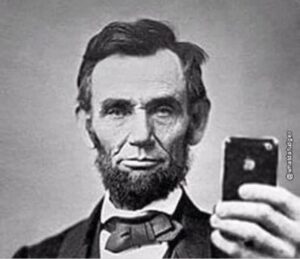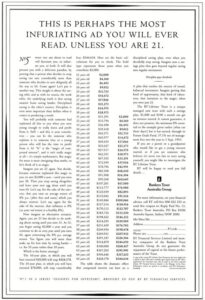Real news: the term ‘fake news’ was named ‘word of the year’ in 2017 by the Collins dictionary.
Fake news: the Great Wall of China is the only human-made artefact that can be seen from space.
Real news: Abraham Lincoln’s Gettysburg address is only 10 sentences long.
Fake news: in the digital age, short copy outperforms long copy.

Ok, if you made it this far, those of you who aren’t googling ‘Gettysburg address’ are most probably asking yourself “where is he going with this?”.
And the answer to that has to do with illusory truths.
The term ‘illusory truth effect’, describes our tendency to believe something to be true if we hear it often enough – even if it isn’t.
While there are no doubt countless examples we could use here, possibly one of the best-known is that of the Great Wall of China, which – according to legend – is the only human-made artefact visible from space.
Now as facts go, this certainly sounds plausible – given it is over 7,000 miles long – and it is probably something many of us want to be true (especially those selling China as a tourist destination).

But. It. Just. Isn’t. True.
Just ask the astronauts who have been up there. Even Yang Liwei – China’s first man in space – admitted he had not seen the Great Wall, much to the disappointment of his fellow citizens. (The problem is one of contrast – the colour of the wall simply doesn’t stand out enough from the land).
Illusory truths can of course be found everywhere and in every field. In marketing for example, there is an illusory truth about copy length. It basically goes like this:
‘People’s attention spans are decreasing all the time as we are bombarded with more and more data, and we are increasingly communicating via small-screened mobile devices and social media platforms that require brevity. Which is why short copy will always outperform long copy.’
But just like the Great Wall of China example, while it feels like it could be true (after all, scientists have shown our attention spans have reduced from 2 and a half minutes to 45 seconds over the last 20 years), in reality it just isn’t.
The more you tell the more you sell
It wasn’t true decades ago when a study by Dr Charles Edwards of New York University found that advertisements containing 6 facts outperformed those with 4 or 5 facts by a ratio of 3 to 1, and those containing 8 or more facts outperformed those containing only 4 facts – by a massive 5 to 1!!
And nor is it true in the digital age, with various studies finding that long copy landing pages produce significantly higher conversion rates and higher ROI than their short copy equivalents.
And when it comes to blog posts, longer is generally better too, at least according to a 2021 study by Semrush, which found that:
- 7,000+ word articles drive almost 4 times more traffic and 43% more shares than articles of average length (900-1,200 words), and
- Short posts (300-900 words) gain 21% less traffic and 75% less backlinks than articles of average length (900-1,200 words).
As some luminaries put it – ‘the more you tell, the more you sell’.

So why would this be?
Well there could be a few reasons.
For starters, the longer the copy the more likely you are to be found in the first place – and that’s because for SEO purposes, longer copy will generally index much higher (there is a bigger target to aim at).
Secondly, if your reader is inherently interested in the product or service being discussed, then the more detail you give them, the more questions you are able to answer, and the more it positions you as an expert authority. The more complex the product you are selling, and/or the higher the value, the more questions a prospective customer is likely to have.
The best salespeople aren’t known for their brevity, they are known for their storytelling, and for their ability to address buyer concerns. Copy is no different.
Now at this point, and as a self-declared long copy devotee, I could just walk away, feeling smug. But I won’t. I am big enough to admit that short copy absolutely has its place.
For example, if you are:
- selling a product that is low cost and low risk, or
- your reader has already pre-qualified themselves, or
- you are asking the reader to make an emotional decision (rather than rational), or
- you simply have limited space
then short copy is likely to be the best route to go.
What I am really saying here, is that it is horses for courses, and that the right copy length will really depend on the job at hand, including the audience, the product, the medium, and the desired response or outcome.
Zeroing in on what is right for the job often takes a lot of trial and error and refining, with everything from words, font, colour, images, and layout having a big impact on effectiveness. And if you are talking about digital and email marketing, the timing can be critical too.
AB split testing
Which is why testing and learning (AKA AB split testing) is more important now than ever. Once the domain of old-fashioned direct mail marketers, who would test everything from word count to envelope colour, to brochure imagery and countless other variables – all to eke out an extra fraction of a percentage in response rate – AB testing is now very much in the toolkit of modern-day digital marketers. (Google engineers famously ran their first A/B test in the year 2000 in an attempt to determine what the optimum number of results to display on its search engine results page would be.)
At Ensombl, we split test within an inch of our lives. Copy length and structure, timing, calls to action, you name it, we have tested it. Indeed, we’ve probably even tested the subject line for this email!
It’s how we know that Sunday afternoons is the best time to send our weekly roundup emails. It’s how we know that engagement with our social content actually goes up during the January holidays. And it’s how we know what problems advisors are looking to solve and therefore what content is resonating most.
Ultimately, all this testing and learning benefits our corporate partners, who are able to connect with advisors more effectively and more efficiently, helping them drive a better ROI. Indeed, by tapping into the insights of advisors on the Ensombl platform – and effectively co-creating content – our partners enjoy a 45% uplift in responsiveness, compared to standard corporate content.
And that’s not fake news.

